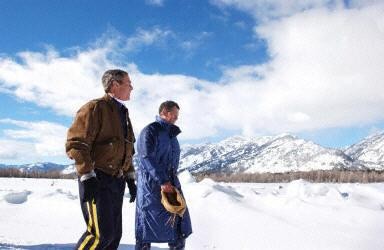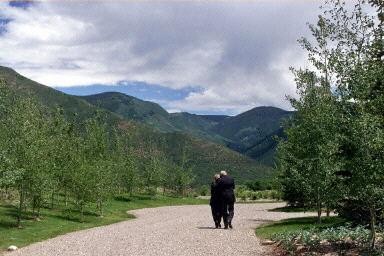Coast to Coast - Part I
Two Lardbutts (Jack Boertlein and Dave "Doc" Richmond, a pair now known as the "Tired 'Butts")...


Tales from the (remote) Lardbutt Peloton, September 23, 2005
Two Lardbutts (Jack Boertlein and Dave "Doc" Richmond, a pair now known as the "Tired 'Butts") recently finished a self-supported, coast-to-coast (west to east) crossing of the United States. They carried their own gear, slept out under the stars for a lot of the trip, and met some wonderful people and a few real "characters". Team Lardbutt travel tip: it's perfectly good manners to show people your gun in Wyoming.
In Part I of their account of this trip, Jack and Dave head off from the Pacific Ocean down through Oregon, Idaho, Montana and Wyoming. Along the way they meet other people riding long distances and locals who think they're crazy for doing so. In between human encounters there's an abundance of mountains and an environment made for enjoying from the saddle of a bicycle. Then there's the old guy with the gun...enjoy.
Never having been in the Northwest United States, I really enjoyed biking though Oregon, Idaho, Montana, Colorado and even Kansas. In Wyoming, going through Yellowstone and the Tetons was the highlight of the trip.
Dave Richmond, Celia, Lisa, and I flew out to Portland, Oregon on July 1, 2005 to start our adventure. We played tourists under the excellent guidance of our friend Judy Dawson, who lives in Vancouver, Washington. Judy took us to Mount St. Helens and the Columbia River Gorge, and Fort Vancouver. On the morning of July 4th, Celia, Lisa, and Judy drove Dave and I up to Astoria, Oregon to start our adventure at the mouth of the Columbia River.
The Oregon coast is beautiful and I touched the Pacific Ocean for the first time. Riding east in Oregon, we rode along streams through a series of valleys and crossed several passes, each one getting drier and having less but different vegetation. I was surprised about the amount of irrigation we saw in eastern Oregon and throughout the rest of the trip in fact. We met two guys who had just released 6,000 trout, and picked great blueberries for $1.50 a pound for those we carried out. Crossing McKenzie Pass (5,325 feet) in the Cascades was our hardest climb. We had to climb about a 3,500-feet and it took us four hours at 5-6 MPH. The top of the pass was a lava field where we had planned to stop for lunch but it was cold and windy so we headed down. Riding down to the town of Sisters was a lot of fun. The Three Sisters mountain peaks with their snow cover were very scenic.
We stopped at all the road signs and saw a lot of historic areas along the way. We crossed the Oregon Trail, followed and crossed Lewis and Clark's path several times, and the Santa Fe Trail. We stopped at several small town museums that gave us a taste of the local history and the Oregon Trail museum in Baker City and the National Historic Oregon Trail Interpretive Centre. In Oregon, we met a guy named Dave at a road stop. He was/is walking from northern California to Jacksonville Florida and expected to be there before Christmas. I met a guy that every other year rides the Ididerod route before the dog race on snowmobiles. He was telling me about his adventures - it takes them about 30 days to make the trip.
Get The Leadout Newsletter
The latest race content, interviews, features, reviews and expert buying guides, direct to your inbox!
Idaho with its rivers, lakes, and gorges was very scenic. We had 97 miles of gentle climbing up the Lochsa River to Lolo Pass. Along the route there was a 66 mile stretch where there was nothing, not even electricity. There was an historic (1920's) Fire Ranger Station that had water but used the original coal oil lamps for light. Along the route we met Ron and his wife. Ron lived in Columbia Md. and retired from NST in 1995. His first multi-day ride was Bike Virginia in 1991. In 1993 he did his first cross-country ride. But since, I think 1995, Ron and his wife had ridden 150,000 miles around the US, Mexico, Panama, Canada, Australia, New Zealand and several other countries, including a 4.5 year nonstop journey following summer seasons throughout the world so they could ride in shorts. Ron said living out of a tent and eating one-pot meals eventually caught up with them. They now live in Tucson Arizona and had completed 2,500 miles of what they thought would be a 5,000-mile trip, and were headed south towards home.
Of the cyclists we met, probably more that 50% were Europeans. We met a couple from Australia who were doing the Continental Divide Route. It mainly follows fire and other non-paved roads from Banff Canada to Antelope Wells New Mexico. They were hoping to complete the entire route. And they had some wild animal encounter stories. We met several "kids" riding cross-country, including one in Virginia carrying his guitar to San Diego. Some of these kids were doing the ride on a shoestring budget. Two guys told us they were spending about $3 each a day. I told him I spent that on Gatorade.
Montana was also great. We stopped in at Adventure Cycling (the organisation that publishes the bike maps we were following) headquarters in Missoula. Got free drinks and ice cream, met one of the founders, and had our picture taken both for the bulletin board and a project they are doing for their 30th anniversary next year. The founder we met is now the art director. He and a group were on a ride from Alaska to the tip of South America (18,000 miles) in 1974 when they came up with the idea of developing a cross-country bike route for the US Bicentennial.
I enjoyed our stay with on Seely Lake with Kris, Jan and Jeanne. Seeing all Jeanne is doing and has done up there was impressive. They have a portable sawmill and are cutting logs to construct a two-story guest house. Kris took us on a day trip to Glacier National Park. It was beautiful and I want to get back there soon with Celia. We drove the "Going to the Sun" Highway and, besides all the glaciers, saw great waterfalls, mountain goats and just lovely scenery.
We met Dave's wife in Butte. In Butte, I asked a young lady in a Subway shop what to do on a Sunday afternoon. She said, "go to a bar...there are more bars in Butte than there are churches". When she found out we had ridden our bikes from Oregon to Butte you could tell she thought we were crazy. She asked why we had done that and I said, "to see Butte". I think, in her mind, that confirmed we were really crazy.
I was awakened by my first earthquake experience, a 5.6er. We were less than 50 miles from the epicentre. It happened the night before we visited Quake Lake. Quake Lake was created as a result of an earthquake on August 17, 1959 which caused a landslide, blocking the river to create the lake. That earthquake also lowered one side of Hebgen Lake by 20 feet, and the waves and landslides killed a dozen or so campers and residents. I'm glad I found this out the day following the earthquake or I may have lost a night's sleep.
Yellowstone National Park is a must see. It was my first time there and Celia and I will go back soon. We entered the west entrance and left via the south entrance so we only saw about a quarter of the park. However, we did see a herd of elk, Old Faithful and several other geysers, various mud pots, the Firehole River gorge (we swam in the river which is heated by the hot springs and geysers), two buffalo, the remains of the fire damage, and, just outside the Park, a mother moose and her calf. The park is very colourful and picturesque. If you have not been there, I would recommend going. The Tetons, which are just south of Yellowstone are quite impressive and the lodges we saw were quite nice.
The rest of Wyoming that we saw was also scenic with some areas that look like the Sonora Arizona area and the high plains with mountains in the background were beautiful. However, it's a very desolate and different state. All the restaurants had signs that said that they had the right to refuse service to anyone. We saw signs in restaurants like, "this ain't Burger King - you don't get it your way" and "you have two choices - our way or no way".
We met very interesting people in Wyoming. Like the 84 year old WWII veteran who said the winters were not bad there, but when I asked him how cold it got he said "oh it gets down to minus 35 degrees". He told us he liked the freedom there - like no one asking why you want a gun when you buy one. And then he showed us the 357 Magnum he was carrying in his vest pocket. When I asked him if he felt he needed to carry it, he responded that he once shot a bear that was walking up on his front porch. We met a guy in a restaurant in Jeffrey City who told us everything you would ever need to know about bear hunting with a gun or bow. He also educated us on how to keep bears out of your camp and them away from any other game you've killed. There were only the three of us and the owner in the place during this whole evening.
In Rawlings we met Jim and Jean Burger who picked us up the next day and took us to their new ranch. We spent the night in their horse training and competition barn. It was not a typical barn - it had an upstairs with a glassed in carpeted judging area with a bar and two bathrooms. They had us over for dinner and breakfast even though they hadn't even been there for a full week. The views from their house are spectacular. Their daughter started school at Johns Hopkins this fall so we hope to see them when they are in the Washington/Baltimore area. Leaving the Burger's ranch, we encountered our worst headwinds of the trip. We only averaged 9.9mph in the morning before we got some relief from the wind.
Even with its beauty, I was glad to leave Wyoming. The sparse population and what appeared to be a very tough and meagre lifestyle was somewhat depressing to me. However, the people we did meet were very friendly and talkative, probably because they don't see many other people. Wyoming road crews spread their asphalt with road graders. It leaves the tire impressions of the graders so that when you ride in them they feel like rumble strips; not the smoothest.